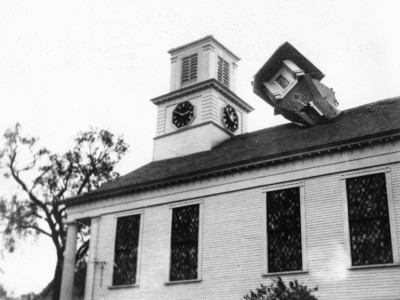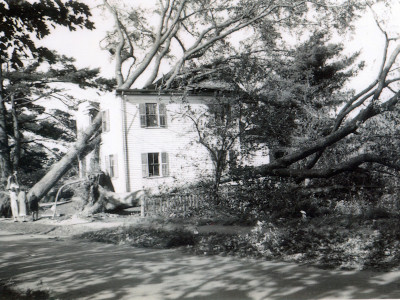May 30, 2020
The Coronavirus pandemic is far from the only deadly phenomenon that the town of Medfield has had to deal with throughout the years.
Many longtime residents remember Hurricane Carol that hit New England back in the late summer of 1954, some 16 years after the sneak attack Hurricane of 1938 (Category 5!) that few living people remember. Carol was the very first major hurricane that made a significant impression on many of the younger generation, the baby boomers growing up in the 1950s.
Watching from a safe distance of their living rooms, many of these Medfield young kids believed that all hurricanes were just as devastating and powerful as Hurricane Carol. That violent storm packed a punch that many Medfield residents will never forget. The storm formed in the Bahamas August 25 and hit Massachusetts six days later, finally leaving the state and continuing up the eastern seaboard in a more weakened weather pattern.
With families safe and sound inside their homes, many children had the run of their homes. The kids sat inside the family living room, transfixed by their windows as they had never witnessed the ravages of any phenomenon like a strong and deadly hurricane before. The children couldn’t watch television because power was out. That prompted some parents to tell their children to “Get a book and read,” while there was light outside with the children seated next to the living room window.
1954 Hurricane stats from Wikipedia
Carol 8/25-9/1-1954 – Category 3 – 72 total fatalities (15 in Mass.) – $462 million in damage ($175m in Mass.) – 115 mph – low barometric pressure 28.2” First and last Hurricane Carol.
Just two weeks later…
Edna 9/2-15/1954 – Category 2 in Mass. – 21 total fatalities – $43 million in damage – 125 mph – 27.9” Very heavy rain, but centered further east, so less overall damage than Carol.
Then three weeks later…
Hazel 10/5-18/1954 – Category 4, but passed west of New England – 1,191 fatalities – $382 million in damage – 130 mph – 27.7” Began in Haiti, passed through VA, MD, PA, NY, heavy damage in Toronto!
—–
1938 9/9-23/1938 – 800 fatalities – $306 million in damage – 162 mph – 27.8” Watch the video
There was a whistling of the strong wind as it blew ajar through the mail slot that was in the middle of the front door of many homes. After hearing that sound, parents would stuff the slot with a cloth towel to prevent the rain-soaked air from blowing into the family home. But the worst was yet to come – while the families remained dry and calm inside, violent, sharp projectiles were flying around outside like small rockets. Many young kids liked seeing all that drama – and the admission was free inside at a front row seat!
In the days before Carol hit, it was brutally hot and humid, but with a foreboding stillness in the air that somehow suggested the onset of a summertime storm. At mid-morning in Medfield center the traffic was already bumper to bumper. Few if any cars had air conditioning back then. With exhaust pollution, the air impeded any reliable semblance of neighborly enthusiasm that people might have had before they stepped outside to the oven heat waiting for them.
Back in 1954 Medfield had no public swim pond, so children cooled off with garden sprinklers, tiny inflatable swimming pools, and “slip-n-slides.” Even though running a home air conditioner could be costly, those noisy, faithful coolers were humming at full blast nearly 24×7.
Outside in the early morning, the steamy heat pattern seemed to radiate visibly from the surface of the black-top streets. Even though basically colorless, one could see the sizzling energy rising in the air before the noon-hour.
But that following day, August 31, 1954, the sky was overcast with brief thunder and lightning. Suddenly, from the darkened clouds overhead, came a violent blast of rain and wind. The rains poured down pearls of pure water that stung one’s skin and beat upon the streets, sounding like a jazz musician banging on a snare drum. The fresh cooling deluge even appeared to buckle the hot and wet street hardtop. The wind and rains were just astonishing; so potent they could pierce and injure one’s eye if one risked looking skyward.
Currents of water began to swamp the streets causing washouts with an unleashed flow for as far as anyone could see in the overcast. Rose and Japanese beetles from the garden, butterflies, dragon flies, cicadas, grasshoppers, locusts and other insects were caught in the violent tide and looked like pinwheels spinning out of control in the air before hitting the street water. Many of them departed this life while jetting in every direction leading to storm drains, clogging the waterways that led to sewers.
The southern end of Pleasant Street, near the Little League field, was flooded to a depth of a foot, and the water covered the pavement for days.
The omnipresent, fast-moving downpour seemed to pursue anything on the street with punishing, crawling, hidden eyes, following some people caught outside no matter how they tried to escape it. With a monstrous and cruel intention, the swift moving currents swallowed and drowned any small house pets it pulled under. Looking back, the water carried with it a sensation of being omnipotent, while rearing up on hind-legs and bringing an overpowering awe of malevolence.
Some of the children secure and safe inside their homes played with their dog and cat and kittens, as well as playing card and board games. They enjoyed eating breakfast cereal, peanut butter and jelly sandwiches, and canned spaghetti with meatballs, heated on a Sterno stove and served by candlelight. The children were sometimes curious but often nearly oblivious to the damage Hurricane Carol was dishing out.
Many sheltered families were mystified while they huddled in their homes, listening to the angry rush battering the land outside. Some of the people in homes on the outskirts of Medfield experienced uprooted trees. Quick erosion on some streets led to sinkholes that almost swallowed small animals. Flora and fauna were destroyed along with other ruined crops of corn, fruits and vegetables. Most of the New England corn crop was destroyed; apple and peach crops sustained heavy losses. Some of the people came to believe that in a spirit of fate, the flooding was just nature’s way of cleaning the aftermath, wiping away the old lifestyle and welcoming in the new.
Although the Historical Society does not have any photos from Hurricane Carol, there are some dramatic pictures from the Hurricane of 1938. One shows the slate-covered steeple piercing the roof of the Unitarian church (the tip of the heavy steeple remains in the church attic); the other shows the partial bisection of the second story of the Blake house at the corner of Adams and Cottage streets.
Once the wind and rain cleared, the streets were illuminated only by backup emergency generators. With only a mild mist falling, noisy and numerous seagulls – the gluttonous bullies of the bird world – drifted down from the low-lying clouds to plunder the burgeoning piles of trash and garbage. After the gulls came the ravens to finish the remaining scraps.
It was only the next day that the townspeople realized that the devastation of the businesses and homes looked like the aftermath of a bomb explosion.
With winds that reached as high as 135 miles per hour many trees like a cherished apple tree in one family’s backyard, and a favorite prized cheery tree belonging to a neighbor were so badly damaged that they had to be cut down. Downed trees and street signs and partially submerged cars in flooded streets hampered traffic.
After September 1, Hurricane Carol subsided and continued in a northerly direction, finally allowing families to emerge from their bunkers to survey the damages. Some houses like the Scribner family’s on Pleasant Street had a giant tree crash onto the right front roof of their home, leaning in place. Fortunately no one in the Scribner family were injured. Luckily the tree had a huge girth, fully grown and was already very close to that corner of their home even before Hurricane Carol. The half fallen tree only caused minimal damage, a far cry from the casualty that could have happened. Shortly afterward Fran Scribner, the father of the family had a tree company remove that tree by straightening it skyward and then positioning it to fall onto another large tree nearby.
Medfield and surrounding towns had power outages lasting for days, prompting many homeowners to buy small portable gas stoves. Some families took advantage of the mild weather in September and cooked their meals in their backyard fireplaces. Dora Palumbo on Frairy Street made a cheese omelet on an impromptu campfire made with large rocks placed in a circle of about two feet in diameter. She then put tinder and firewood in the center of the rocks, set it afire, and cooked scrambled eggs with Velveeta cheese, an omelet called “frittata” in Italian. Aunt Dora continued to make some of her family’s meals outside until the power was restored throughout Medfield.
At Lord’s department store, manager Bill Kelly had to throw out a lot of the frozen food in the store’s freezer due to the power outage. But he was able to give away the half-frozen Popsicles to us grateful kids.
As if Carol wasn’t enough, two weeks later Medfield was deluged by Hurricane Edna!
There are a few things to think about from the experience of surviving hurricanes.
Instead of spending massive amounts of money on mapping the surface of Mars, why not try to better understand the nature of hurricanes and tornadoes here on Earth? It appears that global warming will only make these storms more frequent and deadly. Perhaps meteorologists can continue to enlighten the public.
There are many stories that the people of Medfield have of their very own experiences concerning hurricanes. Medfield residents didn’t let Hurricane Carol get them down due to their tenacity and strength in the face of adversity. We’ve adapted to this life, by living through the hard times with the personal strength derived from our devotion to the well-being of our neighbors and celebrating our triumph over tragedy with better understanding.

